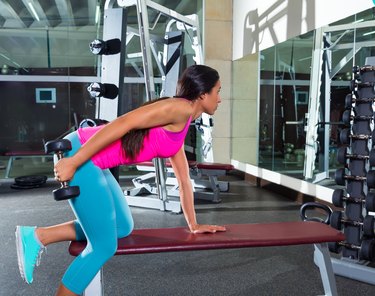
The secret to sculpted arms? Train your triceps. But building your triceps is about more than just looking good in a T-shirt. Toning your tris will build muscle to aid in day-to-day tasks and support the rest of your upper-body muscles.
"A large muscle on the back of the arm that's primarily responsible for the extension of the elbow, the triceps are used in functional, everyday movements like pushing a door open," says Morit Summers, CPT, creator of Brooklyn-based training studio Form Fitness.
Video of the Day
Video of the Day
That's why it's vital you don't neglect them. However, not all triceps exercises are equal. In fact, a popular move — the overhead triceps extension — can do more harm than good if you're not careful.
The Risks of Overhead Triceps Extensions
For starters, many people struggle with the hands-overhead position required in triceps extensions. "Some have a hard time standing straight up without flaring their ribs when they bring their arms overhead," Summers says.
This difficulty may be related to limited shoulder mobility, a common issue that can reduce your shoulders' range of motion, thus making it challenging to straighten your arms above you without discomfort. Consequently, attempting a move like the overhead triceps extension exacerbates the problem and can create new pain points.
"Usually what happens with people who lack shoulder and thoracic [upper back] mobility is they start to compensate in other ways by jutting their neck out of alignment or overarching their lower back," Summers says.
In other words, putting your already weak shoulders in a vulnerable position can lead to injury in them as well as your neck and back. This scenario becomes especially troublesome if you misjudge your strength and lift too heavy.
The More Effective (and Safer) Triceps Exercise
Instead of risking injury with overhead triceps extensions, Summers recommends trying other exercises that efficiently and effectively isolate the triceps while putting your shoulders, neck and back in a less compromising position.
Enter, triceps kickbacks. This tried-and-true move was ranked one of the top three most effective triceps exercises (since it stimulated lots of muscle activity in the tris), according to a small study sponsored by the American Council on Exercise.
Triceps kickbacks are particularly efficient because the greatest resistance happens at the point of maximal contraction (i.e., at the top of the move when the arm is fully extended).
"It's what makes the exercise that much harder," Summers says. "Working to get a muscle into full contraction even without weight is incredibly difficult." That's why you don't need to load the movement with a heavy dumbbell to get serious results.
Ready to feel the burn? Triceps kickbacks target your, yes, triceps — without straining surrounding muscles — and will set the back of your arms aflame.
How to Do Triceps Kickbacks
- With a dumbbell in your right hand, stand in a staggered stance and hinge your hips back, maintaining a straight spine. Your upper body should be just about parallel to the floor.
- With your free arm resting on your front leg, bring your right arm (holding the dumbbell) to your side. Pretending your right elbow is glued to your body, extend your arm straight back in a controlled movement and squeeze the muscle at the top.
- Slowly lower your arm back to starting position. Continue for desired number of reps, then switch sides.